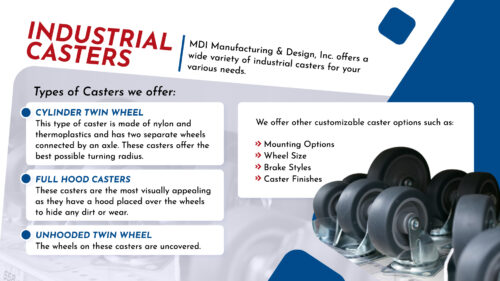Industrial Casters
Furniture & Office Casters
Furniture casters can be found in residential homes, company offices, warehouses, and just about anywhere a movable piece of furniture or cart is needed. Each caster will have different requirements contingent on how and where it will be used. Floor type, load capacities, and directional movement will all determine which caster is best suited for a particular job. The furniture itself will also determine which caster should be used. No matter the furniture piece or location, casters will simplify the task of moving furniture.
Industrial Caster Options
Industrial casters tend to offer more options such as compatible materials, sizes, load capabilities, finishings, and brakes. Institutional casters can often be paired with a variety of different wheel and brake types.
Some of the most popular brake types include:
- Universal
- Top Locking
- Thumb Screw
- A-Lock
- Position Swivel Lock
- Side Locking
- Double Lock
At Manufacturing & Design, Inc., we offer the following finishes:
- Zinc
- Chrome
- Yellow Chromate
- Black Ionic
- Stainless Steel
- And more
Our casters can be used in just about any industry. Some of the most common functions our casters serve are:
- Bins and cases
- Medical equipment carts
- Commercial appliances
- Foodservice and processing equipment
- Retail fixtures
- Residential furniture
- Electronics
- Racks and tables
- Display stands
- Rolling shelves
- Business machines
- Warehouse equipment
- Carts and dollies
Common Caster Wheels Size
Wheel sizes are based on two measurements: the diameter and the width. The diameter pertains to the wheel’s height, whereas width is the wheel’s thickness. Generally, wheels with bigger diameters and widths will have lower rolling and starting resistance. That’s to say it’s easier to get them rolling and keep them rolling. Additionally, they can withstand larger loads and are typically quieter.
A wheel’s properties will achieve certain results. Here are some good rules to know:
- Harder wheels will roll easier.
- Softer wheels will roll easier over rough and bumpy surfaces.
- Soft wheels typically have lower weight capacity than harder wheels.
- The wheel’s capacity increases with its width.
Common wheel sizes that we offer include:
- 50 mm CTW Casters & TW: This caster size has an excellent balance of aesthetics, performance, and cost. They are cheaper, lower profile, and commonly found on economic chairs.
- 75 mm UTW Casters: 75 mm sizing is ideal for heavy-duty casters. Carts, tables, and other items that need even distribution often use this size. Just like most chair casters, these casters can be snapped into the axle.
- 100 mm UTW Casters: These casters are best for high-capacity loads. Additionally, these big caster sizes tend to do better at clearing impediments. They are often produced with a durable, riveted-axle construction.
Types of Caster
Casters are more than just wheels. Their versatile construction, which includes a mounting frame, facilitates a smoother rolling experience across the floor. There are three main types of casters to choose from:
- Cylinder Twin Wheel (CTW): These types of wheel casters are usually constructed from nylon and thermoplastics. As the name implies, they have two wheels that are friction-fitted or riveted on an axle outside the central body. They offer a superior turning radius.
- Full Hood Casters (TW): Full Hooded Casters offer enhanced visual appeal. The hood on these casters will hide the wheels, concealing the dirtiness and wear of the wheels.
- Unhooded Twin Wheel (UTW): In this design, the wheels are entirely exposed. This provides a more technical look, and they are also the more economic option.
Caster Mounting Options
Casters can be attached to just about anything, and the type of item the caster will attach to dictates which type of mount should be used. Below are the most common types of mounting options:
- Grip Ring Stems: These casters are designed to fit in a hole that is slightly larger than the stem. A grip ring is attached to keep the non-threaded stem in place by creating tension.
- Threaded Stems: A threaded system works similarly to a bolt. It is a round piece of metal with a thread that can be fabricated in just about any size thread thickness.
- Grip Neck: Grip necks are typically found on wooden furniture. A flanged top is used to secure the stem in a prefabricated socket.
- Expandable Adapter: Expandable adapters are a more complex option. They typically contain a washer, plastic support pieces, a rubber expander, and a circular nut. This option is often used for mounting casters to circular tubes.
Use MDI For Your Caster Needs
No matter your caster needs, MDI has you covered. We’ve been in the business for nearly three decades and can complete just about any custom order. If you already have a project in mind, feel free to request a quote. For all other inquiries, don’t hesitate to contact us anytime.








